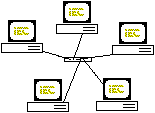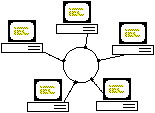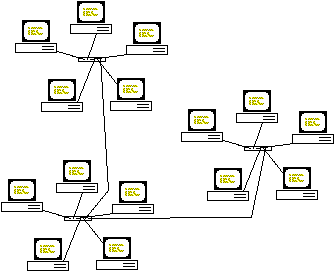A “topology” is a way to network multiple devices. There are four types here: Bus, Star, Ring and Distributed Star.
Bus Topology
![]() In most Bus Topology interfaces, terminators are needed at each end of the bus to make the impedance match properly. The above illustration shows “tee” junctions below the computers, but in many cases, the workstations or equipment will have two ports, one for the cable coming in from the right, and the other for the cable going out to the left. The ADP3356 and its group of “FlashNet” devices each have two ports, for two wires. In other cases, like “Thinnet”, there will be one connector and you’ll need to put a tee on it (the illustration resembles this type of connection). Here are some examples of Bus connections:
In most Bus Topology interfaces, terminators are needed at each end of the bus to make the impedance match properly. The above illustration shows “tee” junctions below the computers, but in many cases, the workstations or equipment will have two ports, one for the cable coming in from the right, and the other for the cable going out to the left. The ADP3356 and its group of “FlashNet” devices each have two ports, for two wires. In other cases, like “Thinnet”, there will be one connector and you’ll need to put a tee on it (the illustration resembles this type of connection). Here are some examples of Bus connections:
| Stations with two ports: |
On stations with two ports, connections require only a cable from one to the next. The FlashNet fits in this category as does the Panasonic Registers used in many fast food restaurants. Notice that there is a plug without a cable at each end device, this plug has a resistor and is a terminator (Please Note: Our FlashNet does not need terminators, in the case of the FlashNet, the end devices will have an open port). |
Thick Ethernet: |
With Thick Ethernet, the bus or wire that runs between the stations is called the TRUNK. The trunk doesn’t connect directly to the stations but instead the trunk connects to transceivers and then a DROP cable connects from the transceiver to the station. The connectors at the ends of the bus (or TRUNK) are terminators. A SPECIAL NOTE about Thick Ethernet, the TRUNK cable has a mark on it every eight and a quarter feet, the only place the cable can be cut or tapped is at a mark, terminating or tapping it at a place between the marks causes signal distortion. When the L0385 is ordered, its length needs to be divisible by 8.25 feet (8.25′, 16.5′, 24.75′, 33, etc.). |
Small Coax (Thinnet would be one example): |
Coax cable busses most often use tees in place of transceivers. The two wires typically go all the way to the computer. Like before, the ends need terminators; the connectors at the ends are terminators. |
The Bus Topology is not used much any more for office LANs, but is still used more for local peripherals, As far as LANs go, the star topology, explained below, has become more popular since it’s so much easier maintain and re-adapt to the ever changing office.
Star Topology

The Star Topology has become the more popular wiring scheme. It’s easier to adjust to the ever-changing office environment. The ideal setup is to run a wire from each wall jack to a single location or “wiring closet”. In the Star topology, not all wall jacks need to be in use. Jacks can be left open and not affect the networks performance. Also, if one wire goes bad, that workstation alone will stop working (in the Bus, if one wire goes bad, the whole network goes down). The center of most star topologies is either a Networking Hub or Networking Switch. Star Topologies require more footage of wire, but they’re easier to troubleshoot and rearrange, so they have become more popular.
Ring Topology

I don’t see the ring that much any more. It’s like the bus except that instead of putting terminators on each end, the connection completes a ring, loop or circle, which means there are no ends. I believe IBM-Token Ring is the only interface that uses the ring topology. There may be others but they don’t seem to be around much, even if they are round. Rings seem to have the same disadvantages as busses, tricky to rearrange and troubleshoot.
Distributed Star (or Tree)

This is where the single hub or switch doesn’t have enough ports, or where a company has networked more than one building. Most Networking Hubs and Switches are daisy-chainable.
Other combinations
It gets even more complex. In some cases, a hub can be one end of multiple busses, branching in different directions, kind of like many strings of Christmas lights plugging into one power strip. The ADP3356 is capable of working in a tree of multiple busses. Since the signal is slow and simple enough, a L0541 harmonica can take the place of a hub. The FlashNet is a cheap alternative to an actual LAN.





